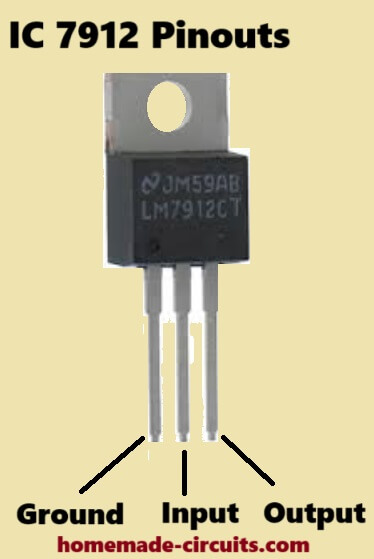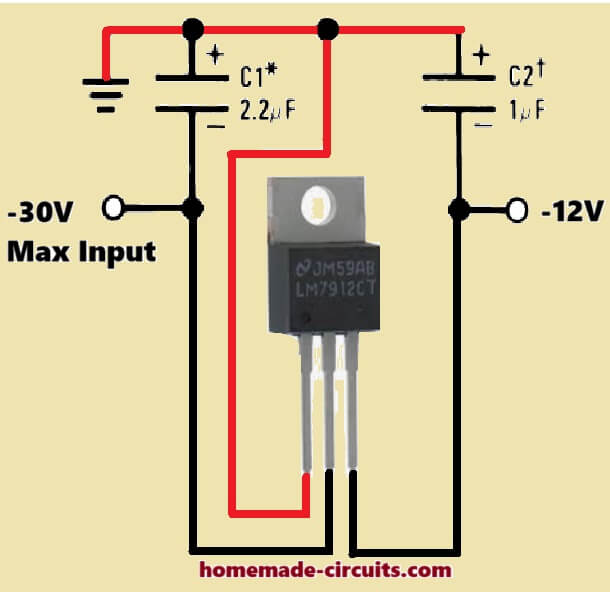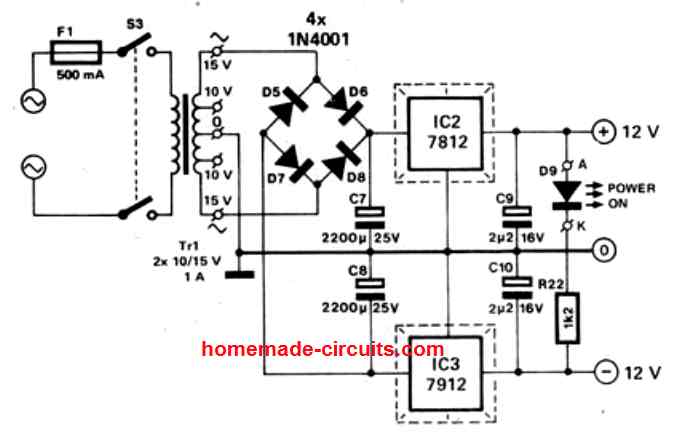In this post we are going to learn about one super old but gold IC called LM7912 or simply IC 7912. This one is not positive regulator like 7805 or 7812, but it is negative regulator which means it gives -12V output and not +12V.
If you are making op-amp circuits or dual power supply projects or analog audio stuff then you know this 7912 is a must. It gives stable negative voltage from a higher negative input voltage. Works super simple, no coding, no setup, just connect and go.
What this LM7912 Does Exactly
So this IC gives fixed -12V DC output and it needs higher negative DC input like -15V to -35V. It will keep output always at -12V even if the input goes little high or the load changes.
It is part of LM79XX family, just like the LM78XX is for positive voltages. So:
| Series | Output Type |
|---|---|
| LM78XX | Positive Regulator |
| LM79XX | Negative Regulator |
Popular LM79XX Variants
| IC Name | Output Voltage |
|---|---|
| LM7905 | -5V |
| LM7912 | -12V |
| LM7915 | -15V |
And yes LM7912 is one of the most used ones, perfect for audio and analog things.
Pinout of LM7912 (TO-220 Package)

We mostly get LM7912 in TO-220 package with metal tab and 3 legs.
| Pin Number | Name | Description |
|---|---|---|
| Pin 1 | GND | Ground (Common pin for input and output) |
| Pin 2 | Input | Connect higher negative voltage |
| Pin 3 | Output | -12V stable output |
Important: Pinout of 7912 IC is reverse compared to LM7812!
So be careful while using it with LM78XX because pins are mirrored.
How to Use LM7912 in Circuit
It is very easy, just plug it like this, as shown below:

We must put two capacitors for stability:
- One input capacitor: 0.33uF or 1uF
- One output capacitor: 0.1uF or 1uF
- For better ripple filtering we can also add 10uF to 100uF electrolytics.
Extra Notes for Using LM78XX or LM79XX Regulator ICs
Remember if your regulator IC is sitting far away from the main filter capacitor, like more than 3 inches (yeah, 3") then you MUST add a capacitor close to the input pin of the regulator. Else it may behave weird or unstable. You can use solid tantalum cap as preferred or a 25uF aluminum electrolytic will also work fine.
Also for making sure the output is rock stable, we MUST put a capacitor on the output side too. Again same story — use solid tantalum if possible but 25uF aluminum electrolytic is OK too. You can even go more than 25uF, no problem at all. Bigger is totally fine here.
Important Safety Tip:
If your output capacitor is huge — like more than 100uF, then you better put a protection diode (like 1N4001 or similar) between input and output pins. Why? Because if the input supply suddenly drops to zero for a moment and output still has charge then it can flow back into the IC and damage it. So this diode acts like a shield, lets current go from output to input safely without hurting the chip.
Input Voltage Range
You must give at least 2V to 3V more than output.
So for LM7912:
- Input = -15V to -30V is safe range.
- Absolute max = -35V (do not cross it, else the IC will die.
- Dropout voltage = around 2V at full load.
Output Current Capacity
- It can give up to 1 Amp safely.
- With proper heatsink you can get full 1A.
- Without heatsink, maybe only 300–400mA or it will heat like toaster.
Heating and Power Dissipation
Same like other linear regulators, this IC 7912 also drops voltage by burning it as heat.
Let us say input = -24V, output = -12V, and load current = 0.5A.
Then power loss = (24 - 12) × 0.5 = 6 Watts.
So it will get very hot, and so it will need metal tab or heatsink or will shutdown using internal thermal shut down.
Protections Inside the Chip
Short circuit protection.
Thermal shutdown protection.
Safe area control (prevents chip from damage).
So even if you short output to ground, still it will not burn instantly.
Where We Use LM7912
We use this IC mostly when we want dual power supply or negative rail for analog and audio things.
Here are some examples:
- Op-Amp circuits with ±12V or ±15V.
- Audio preamps and mixers.
- DAC and ADC circuits.
- Analog sensor interface.
- Old telecom and radio projects.
- Laboratory power supply (+/- rails).
Practical Dual Supply with LM7812 + LM7912

You can use both 7812 and 7912 together to make +12V and -12V supply for op-amps and analog ICs.
Advantages of the IC 7912
- It can generate Super stable -12V output.
- Generates No noise, only clean supply.
- It is Easy to use, no setup required.
- It has Built-in protections, like over current and overload protections.
- Works perfectly with audio and analog systems.
Disadvantages
- It is Not efficient (because it is a linear regulator).
- It can Get hot if input/output voltage drop is big.
- Gives Only fixed output, and not adjustable.
- It Needs big input supply if load is high.
Conclusions
So this LM7912 is like that dependable component in analog circuit world. When we want negative 12V, no questions asked, we just use this. It is old school but still reliable as hell.
Just do not forget: it is a negative regulator, so input and output both are negative voltages. Also remember: pinout is different from LM7812, so do not mix up else the IC will fry.
And yes, for heavy loads always use heatsink or else it will turn into frying pan.